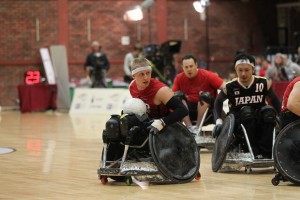
Wheelchair Rugby World Cup 2011: GB v Japan ©Steve Pope
The rugby community is waiting with bated breath for 2016 when the rugby sevens will be incorporated into the Olympics. However, it is less well-known that a type of rugby is already to be included in this year’s Paralympics in the form of Wheelchair Rugby.
Wheelchair rugby was featured in the Oscar-nominated documentary “Murderball” a few years ago, but even the most sophisticated rugby lovers are often unfamiliar with the sport.
I hope this article illuminates the sport, brings a new rugby following to Wheelchair Rugby and encourages the rugby community to support the Great Britain team in this year’s Paralympics.
Introduction
Make no mistake; wheelchair Rugby is a full contact sport and a very exciting one to watch. It is a team sport for athletes with a disability, which is played in over twenty countries around the world.
The sport was developed in 1977 and originally called “Murderball” due to its aggressive nature although in the United Kingdom it is now called “Wheelchair Rugby”.
Unlike rugby union, Wheelchair Rugby is played inside on a hardwood court the size of a basketball court. The teams consist of up to twelve players but only four players are allowed on the court at any time. One of the most interesting aspects is that it is a mixed gender sport, so both male and female players play on the same team.
The spirit of the game is very similar to rugby union as we know it. Players love the fast paced and aggressive nature of the game that allows them to bosh other players and indeed many of the players are former men’s and women’s rugby players.
“Its face paced, hard-hitting and full of contact,” said Mandip Sehmi, a member of the Great Britain Paralympics team.
Here the GB players describe what they love about Wheelchair Rugby:
The Great Britain Team
In May, the British Paralympic Association named the Paralympic squad, which included six debutants, including one woman, Kylie Grimes, in its 11-strong Paralympics team.
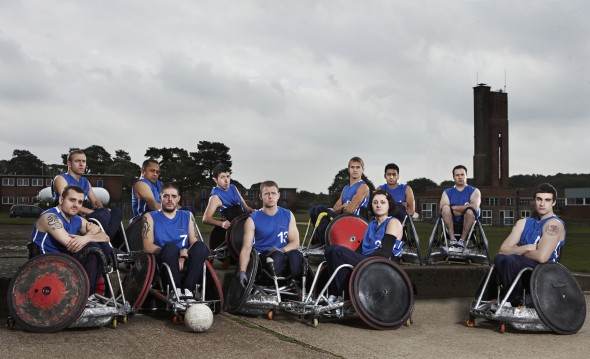
“I have always been sporty and wheelchair Rugby is a male dominated sport which tends to be fast, strong and very competitive, which I love,” Grimes said.
You can listen to a great interview with Kylie Grimes here where she describes the physicality of the sport and the team’s chances at this year’s Olympics.
The squad is placed sixth in the world at the moment, but the team finished fourth four years ago in Beijing and the team is focussed on medalling this year with the advantage of having the game on home soil.
“We are definitely looking for a medal out of this Games,” said British Wheelchair Rugby chief David Pond.
Players
To be eligible to play wheelchair Rugby, athletes must have some form of neurological disability that involves at least three limbs or a non-neurological disability that involves all four limbs. Indeed in the United States the game is called “quad rugby” as a result of it and most are medically classified as quadriplegic.
Players are classified according to their functional level and assigned a point value ranging from 0.5 (the lowest functional level) to 3.5 (the highest). The total classification value of all players on the court for a team at one time cannot exceed eight points, so there is strategy behind whom you play on the floor at any given time.
The reality of the sport is that the majority of athletes have spinal cord injuries, amputations, cerebral palsy, or other serious medical conditions.
For many the sport seems to provide an important goal and lifelong ambition to represent their country. It is clear that all of the players competing at the highest levels are true athletes with real athletic talents, ambition and drive to compete.
“I first heard more about wheelchair Rugby when I was undergoing 5 months of rehabilitation at Stanmore after a rugby injury in 1997. After watching an exciting match I was determined to carry on competing and play myself,” Andy Barrow, a member of the GB team, said.
“Before my injury I was very ‘sporty’, and played Football, running and Cricket as well as skiing whatever was going on really. After the accident I was quite down and went and watched a game of Wheelchair Rugby and saw people in the same position as me, some with far worse injuries. They were playing professionally and living as real athletes and it gave me a direction, I decided it was the sport for me. I’d never have taken up sport as a profession before my accident, but doing so gave me a focus, I changed my lifestyle to that of an athlete and am conscious about training, what I eat and what I drink, so much so that the sport has become my lifestyle”, Steve Brown, Captain of the GB team said.
These players train and compete at the most intense levels much like other able-bodied rugby players. If anyone doubts the physicality of the game, just read what Brown said in regard to his worst rugby injury:
“It was a sporting injury playing Wheelchair Rugby in Germany in 2009. My chair was hit by two players at the same time and I flew out of it and landed across their knees, broke my sternum along with other complications. I didn’t realize how badly hurt I was at first and drove back home but the next day my chest was black and blue and I ended up in intensive care for 3 days, hospital for 6 weeks and then couldn’t play for 4 months so missed some big competitions. It also put my training and career back somewhat.”
The Rules
Wheelchair Rugby is played indoors on a hardwood court of the same measurements as a regulation basketball court. Games consist of four eight-minute quarters and if the game is tied at the end of play a three-minute overtime period is played.
Like rugby union, the point is to score goals by carrying the ball across the goal line and for a goal to count the two wheels of a player’s wheelchair must cross the line while the player has possession of the ball.
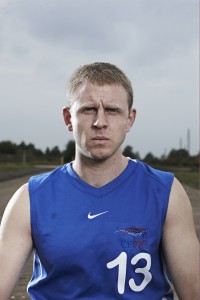 Physical contact between wheelchairs is permitted and is a major component of the game. However, direct physical contact between players is not allowed.
Physical contact between wheelchairs is permitted and is a major component of the game. However, direct physical contact between players is not allowed.
The clock is stopped when a goal is scored, or in the event of a violation such as the ball being played out-of-bounds or a foul having been committed.
Like rugby union, games are fluid and fast-moving, with possession switching back and forth between the teams while play continues. Players may be substituted but only during a stoppage in play.
Unlike rugby union, a player with possession of the ball must bounce or pass the ball within ten seconds and teams have twelve seconds to advance the ball from their back court into the front court and a total of forty seconds to score a point or concede possession.
A team is not allowed to have more than three players in their own defensive key (an area measuring 8 metres wide by 1.75 metres deep at each end of the court) while they are defending their goal line. Offensive players are not permitted to remain in the opposing team’s key for more than ten seconds.
Fouls are penalised by a one-minute penalty and in some cases a penalty goal may be awarded in lieu of a penalty. Common fouls include spinning (striking an opponent’s wheelchair behind the main axle), illegal use of hands or reaching in (striking an opponent with the arms or hands), and holding (holding or obstructing an opponent by grasping with the hands or arms, or falling onto them).
The wheelchair Rugby ball is identical in size and shape to a regulation volleyball but the balls are normally over-inflated compared to a volleyball, to provide a better bounce.
You can check-out some great Wheelchair Rugby highlights here:
Competitions
The first international tournament was held in 1989 and now there are numerous international competitions including the Zone Championships, the World Championships, and the Paralympic Games. Wheelchair Rugby debuted in the Paralympics in Sydney in 2000 and since then the game has gone from strength to strength.
The sport is governed by the International Wheelchair Rugby Federation (IWRF) which was established in 1993.
There is also a rugby league wheelchair rugby, which was developed by a French rugby league player, coach and official, Robert Fassolette in 2004. However, unlike Wheelchair Rugby and other wheelchair sports, people without disabilities are allowed to compete in the sport.
Call of Action
When asked what makes Paralympics so special, Captain Steve Brown said, “The games are special because the athletes have gone through so much and often have a lot of other challenges to overcome. They have had to cope with a lot more in their lives than just the sport, the training and dedication. When life gives you a bad hand it is very easy to give up, you have to admire the athletes involved in the Paralympics for carrying on.”
Tickets for the sport at London 2012 sold out in record time (I myself have snagged a pair), so do get down and support our British athletes this September and check out the sport on your television screens.
Full squad: Steve Brown (captain), David Anthony, Andy Barrow, Jonny Coggan, Kylie Grimes, Bulbul Hussain, Mike Kerr, Ross Morrison, Myles Pearson, Aaron Phipps and Mandip Sehmi.








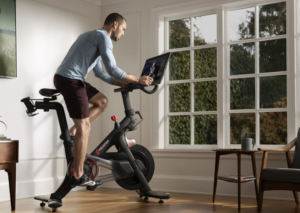 When most people hear the word “Peloton” they think of an expensive black bike with shiny red buttons and that controversial commercial where the husband gifted his wife a Peloton for Christmas.
When most people hear the word “Peloton” they think of an expensive black bike with shiny red buttons and that controversial commercial where the husband gifted his wife a Peloton for Christmas.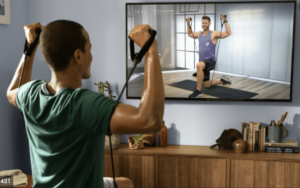 If the app interests you, Peloton is currently offering a 30 day FREE TRIAL, so why not give it a try? Check it out
If the app interests you, Peloton is currently offering a 30 day FREE TRIAL, so why not give it a try? Check it out 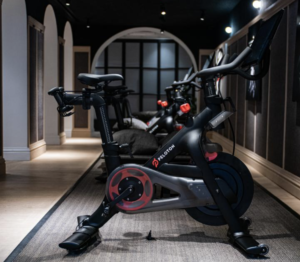
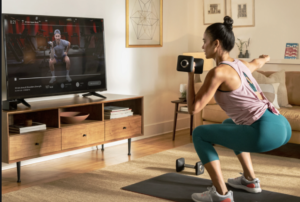
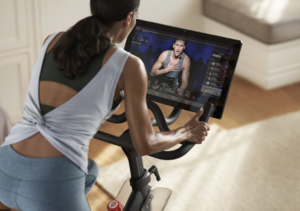 This article would not be complete, however, if we did not acknowledge some of the delivery issues that have been plaguing Peloton over the last year. Most of the delivery issues seem to affect U.S. deliveries, however, the UK deliveries have been affected as well.
This article would not be complete, however, if we did not acknowledge some of the delivery issues that have been plaguing Peloton over the last year. Most of the delivery issues seem to affect U.S. deliveries, however, the UK deliveries have been affected as well.







